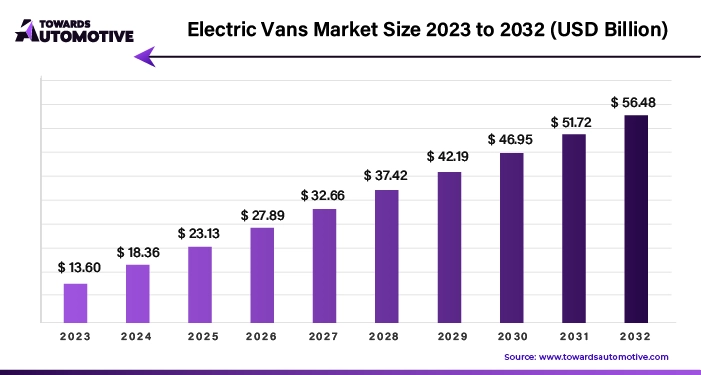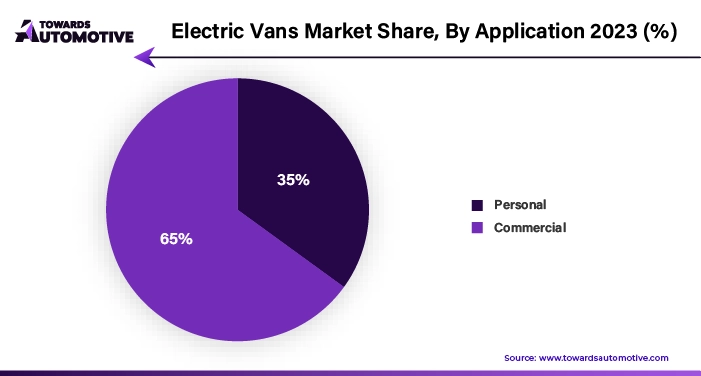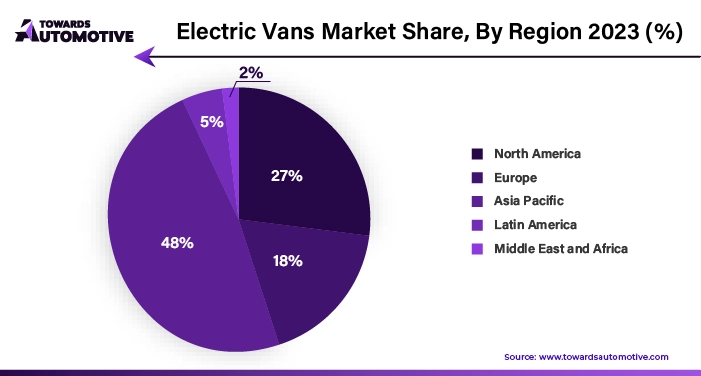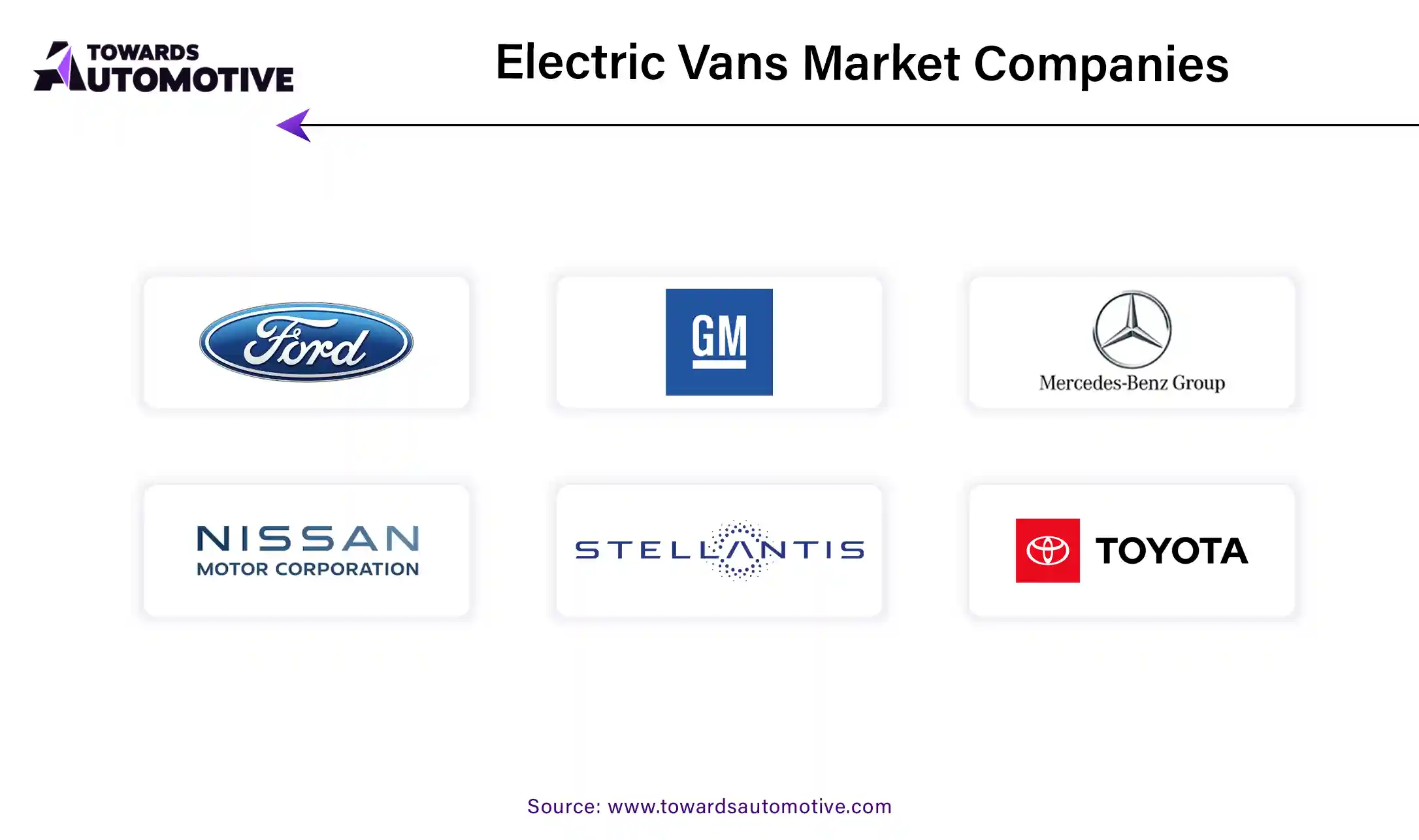April 2025
The electric vans market is forecasted to expand from USD 18.66 billion in 2025 to USD 77.50 billion by 2034, growing at a CAGR of 17.14% from 2025 to 2034.
Unlock Infinite Advantages: Subscribe to Annual Membership
The global landscape for electric vehicles, particularly electric trucks, has witnessed significant growth and development driven by various government initiatives, environmental concerns, and advancements in technology. In countries like India, the government has implemented programs such as the National Electric Mobility Mission Program (NEMMP) and FAME India to promote the adoption of electric vehicles (EVs). Under FAME India, subsidies are provided for the purchase of EVs, while initiatives like the PLI-ACC program and battery replacement policy further support the EV ecosystem. The establishment of toll booths under FAME India underscores the government's commitment to facilitating EV infrastructure development.
Globally, heightened awareness of environmental issues and stricter emissions regulations have propelled the demand for electric trucks. With zero emissions, electric trucks offer a sustainable solution to reducing pollution and combating climate change. Governments worldwide have responded by offering incentives and support to incentivize the use of electric vehicles, including trucks.
Major corporations like Amazon are also making significant strides in promoting environmental sustainability by transitioning to electric vehicles. Amazon's partnership with electric vehicle manufacturer Rivian exemplifies this commitment, with plans to expand its electric fleet to 100,000 vehicles by 2030. This transition not only aligns with corporate sustainability goals but also serves as a testament to the economic viability and potential of electric vehicles.
The Total Cost of Ownership (TCO) benefits associated with electric vehicles present a compelling case for their adoption. While the upfront purchase price of electric vehicles may be higher, reduced operating and maintenance costs, along with incentives, make them financially attractive in the long run. Additionally, electric trucks often benefit from lower fuel and maintenance costs compared to their traditional counterparts, further contributing to the TCO advantage.
Manufacturers like Mercedes-Benz are also investing in the development of electric vehicles, aiming to reduce costs and increase market share. Ambitious targets for the electrification of pickup trucks indicate a strong commitment to transitioning towards sustainable transportation solutions.
However, challenges such as range anxiety, charging infrastructure limitations, and regulatory uncertainties pose hurdles to widespread electric vehicle adoption. Overcoming these obstacles will be crucial in driving sales and fostering the growth of the electric vehicle market in the coming years. Nonetheless, the momentum towards electrification, coupled with government support and corporate initiatives, suggests a promising future for electric trucks and the broader electric vehicle industry.
The COVID-19 pandemic has indeed had a significant impact on the electronics industry, causing disruptions in production and financial challenges for companies worldwide. Supply chain disruptions, factory closures, and shifts in consumer demand have all contributed to delays and financial strains for electronics manufacturers.
However, amidst these challenges, the pandemic has also fueled increased interest in clean transportation solutions, particularly electric trains. As awareness of public health and environmental issues grows, there is a growing emphasis on transitioning towards sustainable modes of transportation. Electric trains offer a cleaner and more eco-friendly alternative to traditional diesel-powered trains, contributing to efforts to reduce air pollution and combat climate change.
For businesses seeking to adopt sustainable transportation options, electric trains present a compelling choice. Not only do they align with environmental sustainability goals, but they also offer long-term benefits such as reduced operating costs and lower emissions. Furthermore, the global push towards electrification in the transportation sector, coupled with government incentives and support, creates favorable conditions for businesses to make the transition to electric trains.
COVID-19 pandemic has posed challenges for the electronics industry, it has also underscored the importance of sustainable transportation solutions like electric trains. As businesses prioritize environmental sustainability and seek cleaner transportation options, electric trains emerge as a viable and advantageous choice, offering both economic and environmental benefits in the post-pandemic world.
Technological advancements play a crucial role in strengthening the electric vehicle market forecast, particularly in the realm of electric vans and trucks. The development of battery technology holds immense significance, as it directly impacts the range, charging speed, and longevity of electric vehicles. By addressing key challenges faced by consumers and businesses, such as range anxiety and charging infrastructure limitations, advancements in battery technology enhance the appeal and practicality of electric vans and trucks.
Moreover, innovations in connectivity, data analysis, and self-management capabilities offer opportunities to increase efficiency, reduce operating costs, and introduce new solutions in the transportation sector. These technologies enable fleet management optimization, predictive maintenance, and remote diagnostics, enhancing the overall performance and reliability of electric trucks. Additionally, connectivity features facilitate real-time monitoring and management, ensuring seamless integration into existing transportation networks.
The transition to electric vehicles represents a significant paradigm shift in the transportation sector, offering long-term benefits for both businesses and the environment. As governments and industries increasingly prioritize sustainability and emissions reduction, electric vehicles emerge as a pivotal solution to address climate change and air pollution.
An illustrative example of this transition is demonstrated by Bedeo's announcement in September 2023. Bedeo's initiative to convert diesel trains into electric hybrids in France leverages government incentives to accelerate the adoption of renewable energy solutions. By utilizing innovative technologies such as Protean Electric in-wheel motors, Bedeo aims to retrofit diesel vehicles with electric drivetrains, reducing emissions and improving efficiency.
With a growing momentum towards electric vehicles, the demand for electric trucks is poised to surge in the coming years. As technology continues to evolve and adoption rates increase, electric vans and trucks are positioned to play a central role in driving the transportation revolution towards a cleaner and more sustainable future.
The hybrid electric vehicle (HEV) segment is anticipated to capture a substantial 60% market share by 2022, reflecting the growing importance of hybrid technology in the transition towards green transportation. Hybrid trucks, which integrate traditional combustion engines with electric power, offer an effective solution for enhancing fuel efficiency and reducing emissions. This makes them particularly appealing to businesses seeking to minimize their carbon footprint while maintaining operational flexibility.

Hybrid vans also play a significant role in this transition by providing extended driving range and lower operating costs compared to fully electric models. This makes them an attractive option for businesses that may not yet be ready to fully transition to electric vehicles but still want to benefit from reduced emissions and enhanced efficiency.
In terms of application, the commercial segment is expected to dominate the electric vehicle market, accounting for over 60% of market share by 2022. Commercial electric vehicles offer several advantages over traditional vehicles, including reduced maintenance requirements and operational costs. Moreover, they contribute to environmental sustainability by emitting zero waste emissions, aligning with sustainable business objectives and government regulations aimed at reducing greenhouse gas emissions.
The continued advancement of battery technology, coupled with the expansion and improvement of charging infrastructure, further enhances the economic viability of electric vehicles. These advancements lead to increased efficiency and longer driving ranges while simultaneously reducing carbon emissions, making electric vehicles an increasingly attractive option for businesses and consumers alike.
Overall, the combination of hybrid technology and advancements in electric vehicle technology is driving significant growth in the electric vehicle market. As businesses and governments prioritize sustainability and seek to reduce emissions, electric vehicles, including hybrids and fully electric models, are poised to play a crucial role in shaping the future of transportation towards a cleaner and more sustainable future.
The Asia-Pacific electric vehicle market is poised for substantial growth, with projections indicating an estimated value of US$10.2 billion by 2022. This growth is driven by several factors, including increasing attention to environmental sustainability and government initiatives aimed at promoting electric vehicles.

Governments worldwide, including China, are implementing regulations and incentives to encourage the adoption of electric vehicles. For instance, in June 2023, China announced a significant tax incentive amounting to $72.3 billion over four years to promote electric and environmentally friendly vehicles. This incentive includes full tax exemptions for new energy vehicles (NEVs) purchased in 2024 and 2025, potentially saving buyers up to $4,170 per vehicle. Although the exemption amount will be halved from 2026 to 2027, with a maximum of $2,078, it still represents a substantial incentive for consumers to opt for electric vehicles.
The increasing urbanization and population density in major cities across the Asia-Pacific region have further fueled the demand for clean and efficient transportation solutions, including electric trucks. Electric trucks offer a sustainable alternative to traditional diesel vehicles, addressing concerns related to air pollution and congestion in urban areas.
Moreover, the region's developed capacity and strategic location within the Asia-Pacific contribute to the competitiveness of electric vehicle products. With established manufacturing capabilities and access to key markets, Asia-Pacific countries can produce electric vehicles cost-effectively, making them more accessible to consumers.
Overall, the combination of government incentives, growing environmental awareness, and the need for efficient transportation solutions in urban areas positions the Asia-Pacific electric vehicle market for significant growth in the coming years. As the adoption of electric vehicles continues to accelerate, the region is expected to play a pivotal role in driving the global transition towards sustainable mobility.

Major companies operating in the electric vans industry are:
Stellantis NV, with its extensive portfolio of car brands including Peugeot, Citroën, and Fiat, stands out as a dominant force in the electric van market. Leveraging its diverse range of brands, Stellantis offers a variety of electric van models tailored to meet the needs of different business segments.
One of Stellantis' key strengths lies in its established position within the van industry. With a wealth of experience and expertise in vehicle design and manufacturing, Stellantis has a deep understanding of the unique requirements and challenges associated with commercial vehicles. This knowledge enables the company to develop electric van models that not only meet but exceed the expectations of businesses and fleet operators.
Stellantis has demonstrated its proficiency in converting high-quality van models into electric vehicles. By leveraging its existing van platforms and integrating electric drivetrain technology, Stellantis can efficiently produce electric vans that uphold the same standards of quality, reliability, and performance as their conventional counterparts.
Stellantis' significant presence in the electric van market, combined with its expertise in vehicle design and conversion, positions the company as a formidable player in the transition towards sustainable transportation solutions. As the demand for electric vans continues to grow, Stellantis is well-equipped to capitalize on this trend and maintain its dominance in the market.
By Propulsion
By Range
By Battery Type
By Application
By Geography
April 2025
April 2025
April 2025
April 2025
We offer automotive expertise for market projections and customizable research, adaptable to diverse strategic approaches.
Contact Us